Autism and Learning (EDGS951) Assessment 1: Short Answer Analysis
VerifiedAdded on 2020/07/22
|12
|4298
|283
Homework Assignment
AI Summary
This homework assignment, completed by a student, addresses key aspects of Autism Spectrum Disorder (ASD). The assignment begins by debunking six common myths about autism, providing factual restatements for each. It then delves into the history and diagnosis of ASD, highlighting the contributions of Leo Kanner and Hans Asperger, and tracing the evolution of diagnostic criteria through the DSM. The assignment further explores the best practices in diagnosing ASD, emphasizing the role of multidisciplinary professionals. Finally, it examines five common characteristics of individuals on the autism spectrum, such as information processing and communication challenges, and discusses the impact of these characteristics in various environments, like a school setting, providing examples and references to support the analysis. This assignment showcases the student's understanding of the research on ASD and its impact on individuals.
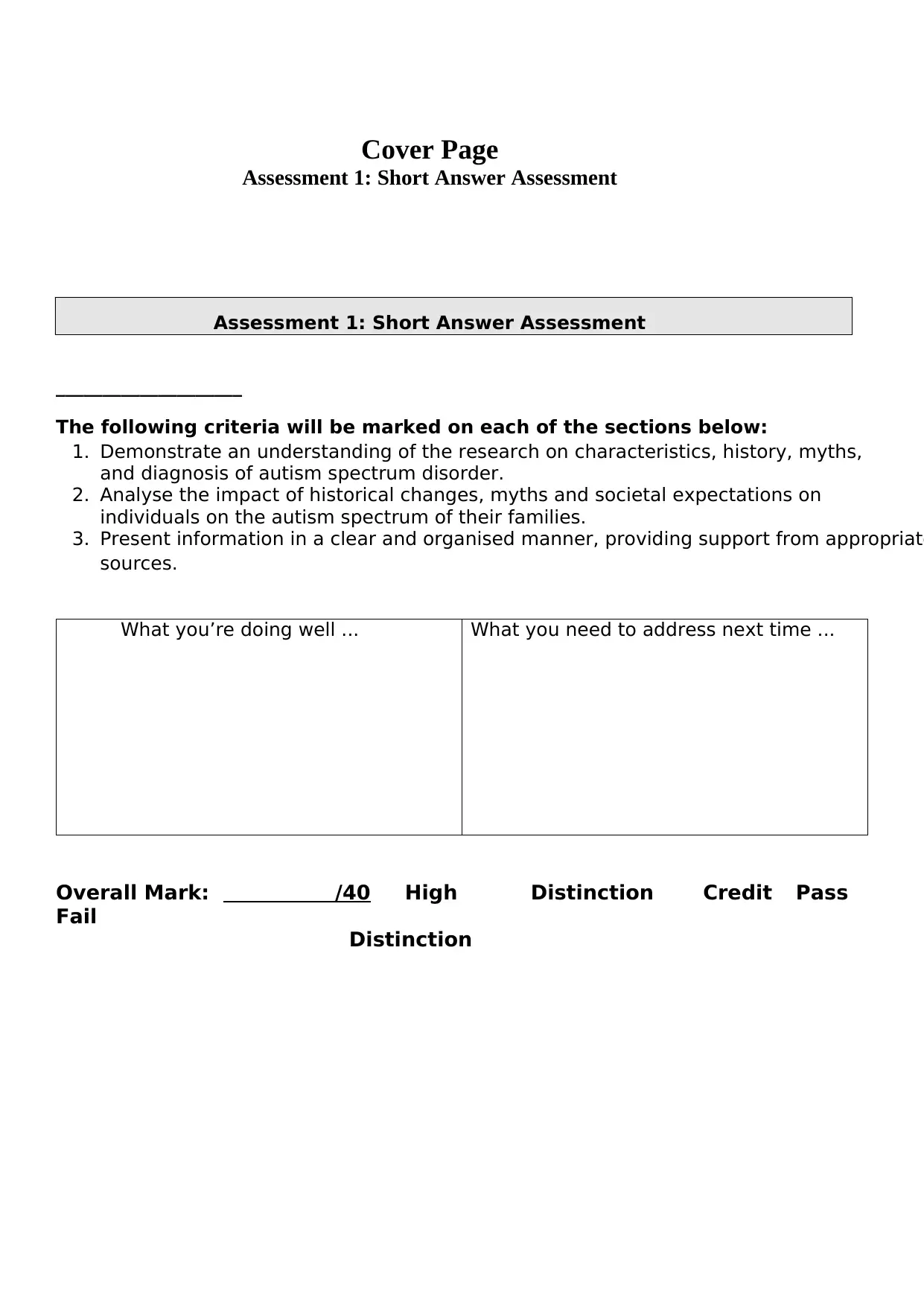
Cover Page
Assessment 1: Short Answer Assessment
Assessment 1: Short Answer Assessment
____________________
The following criteria will be marked on each of the sections below:
1. Demonstrate an understanding of the research on characteristics, history, myths,
and diagnosis of autism spectrum disorder.
2. Analyse the impact of historical changes, myths and societal expectations on
individuals on the autism spectrum of their families.
3. Present information in a clear and organised manner, providing support from appropriate
sources.
What you’re doing well ... What you need to address next time ...
Overall Mark: /40 High Distinction Credit Pass
Fail
Distinction
Assessment 1: Short Answer Assessment
Assessment 1: Short Answer Assessment
____________________
The following criteria will be marked on each of the sections below:
1. Demonstrate an understanding of the research on characteristics, history, myths,
and diagnosis of autism spectrum disorder.
2. Analyse the impact of historical changes, myths and societal expectations on
individuals on the autism spectrum of their families.
3. Present information in a clear and organised manner, providing support from appropriate
sources.
What you’re doing well ... What you need to address next time ...
Overall Mark: /40 High Distinction Credit Pass
Fail
Distinction
Paraphrase This Document
Need a fresh take? Get an instant paraphrase of this document with our AI Paraphraser
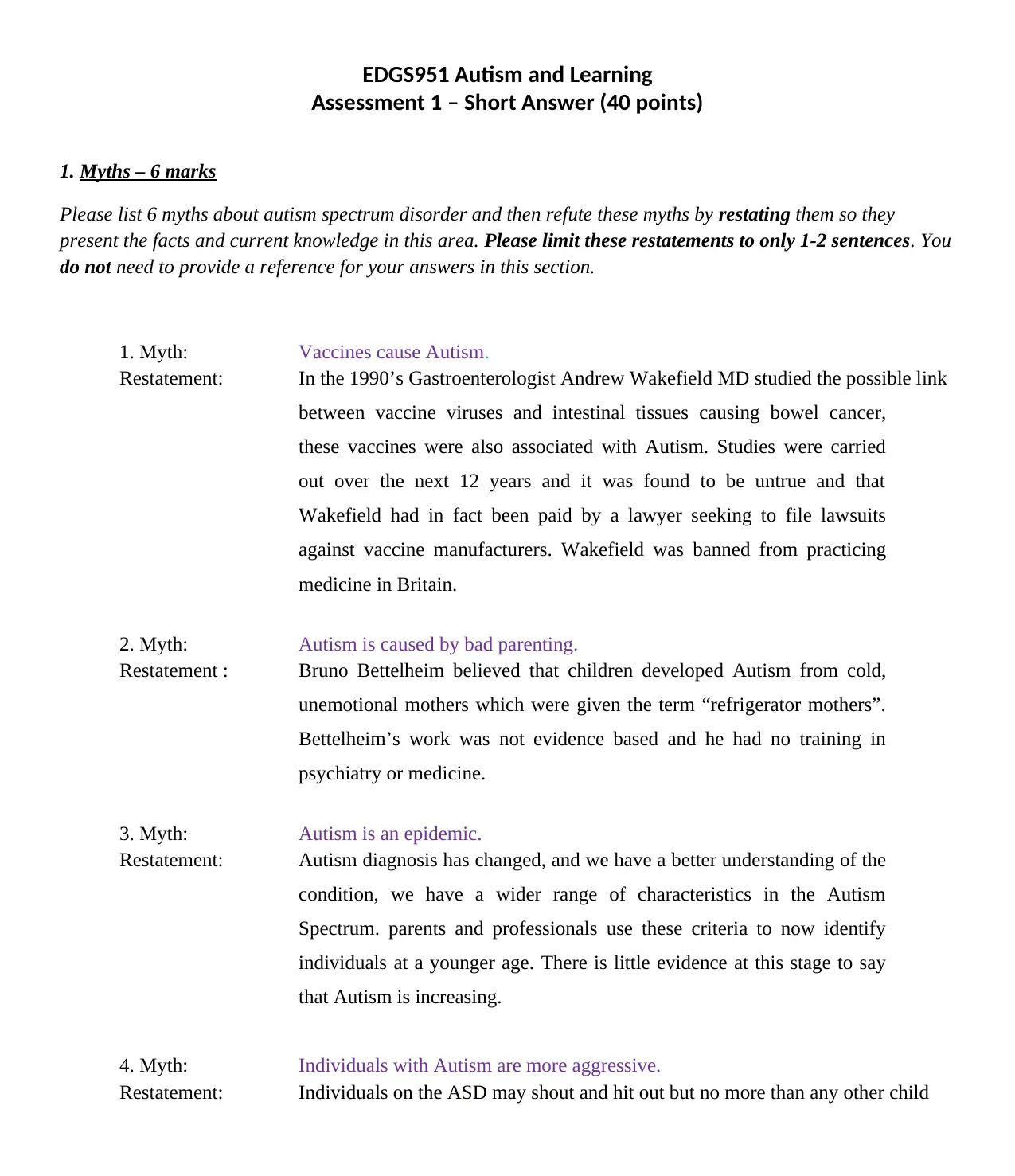
EDGS951 Autism and Learning
Assessment 1 – Short Answer (40 points)
1. Myths – 6 marks
Please list 6 myths about autism spectrum disorder and then refute these myths by restating them so they
present the facts and current knowledge in this area. Please limit these restatements to only 1-2 sentences. You
do not need to provide a reference for your answers in this section.
1. Myth: Vaccines cause Autism.
Restatement: In the 1990’s Gastroenterologist Andrew Wakefield MD studied the possible link
between vaccine viruses and intestinal tissues causing bowel cancer,
these vaccines were also associated with Autism. Studies were carried
out over the next 12 years and it was found to be untrue and that
Wakefield had in fact been paid by a lawyer seeking to file lawsuits
against vaccine manufacturers. Wakefield was banned from practicing
medicine in Britain.
2. Myth: Autism is caused by bad parenting.
Restatement : Bruno Bettelheim believed that children developed Autism from cold,
unemotional mothers which were given the term “refrigerator mothers”.
Bettelheim’s work was not evidence based and he had no training in
psychiatry or medicine.
3. Myth: Autism is an epidemic.
Restatement: Autism diagnosis has changed, and we have a better understanding of the
condition, we have a wider range of characteristics in the Autism
Spectrum. parents and professionals use these criteria to now identify
individuals at a younger age. There is little evidence at this stage to say
that Autism is increasing.
4. Myth: Individuals with Autism are more aggressive.
Restatement: Individuals on the ASD may shout and hit out but no more than any other child
Assessment 1 – Short Answer (40 points)
1. Myths – 6 marks
Please list 6 myths about autism spectrum disorder and then refute these myths by restating them so they
present the facts and current knowledge in this area. Please limit these restatements to only 1-2 sentences. You
do not need to provide a reference for your answers in this section.
1. Myth: Vaccines cause Autism.
Restatement: In the 1990’s Gastroenterologist Andrew Wakefield MD studied the possible link
between vaccine viruses and intestinal tissues causing bowel cancer,
these vaccines were also associated with Autism. Studies were carried
out over the next 12 years and it was found to be untrue and that
Wakefield had in fact been paid by a lawyer seeking to file lawsuits
against vaccine manufacturers. Wakefield was banned from practicing
medicine in Britain.
2. Myth: Autism is caused by bad parenting.
Restatement : Bruno Bettelheim believed that children developed Autism from cold,
unemotional mothers which were given the term “refrigerator mothers”.
Bettelheim’s work was not evidence based and he had no training in
psychiatry or medicine.
3. Myth: Autism is an epidemic.
Restatement: Autism diagnosis has changed, and we have a better understanding of the
condition, we have a wider range of characteristics in the Autism
Spectrum. parents and professionals use these criteria to now identify
individuals at a younger age. There is little evidence at this stage to say
that Autism is increasing.
4. Myth: Individuals with Autism are more aggressive.
Restatement: Individuals on the ASD may shout and hit out but no more than any other child
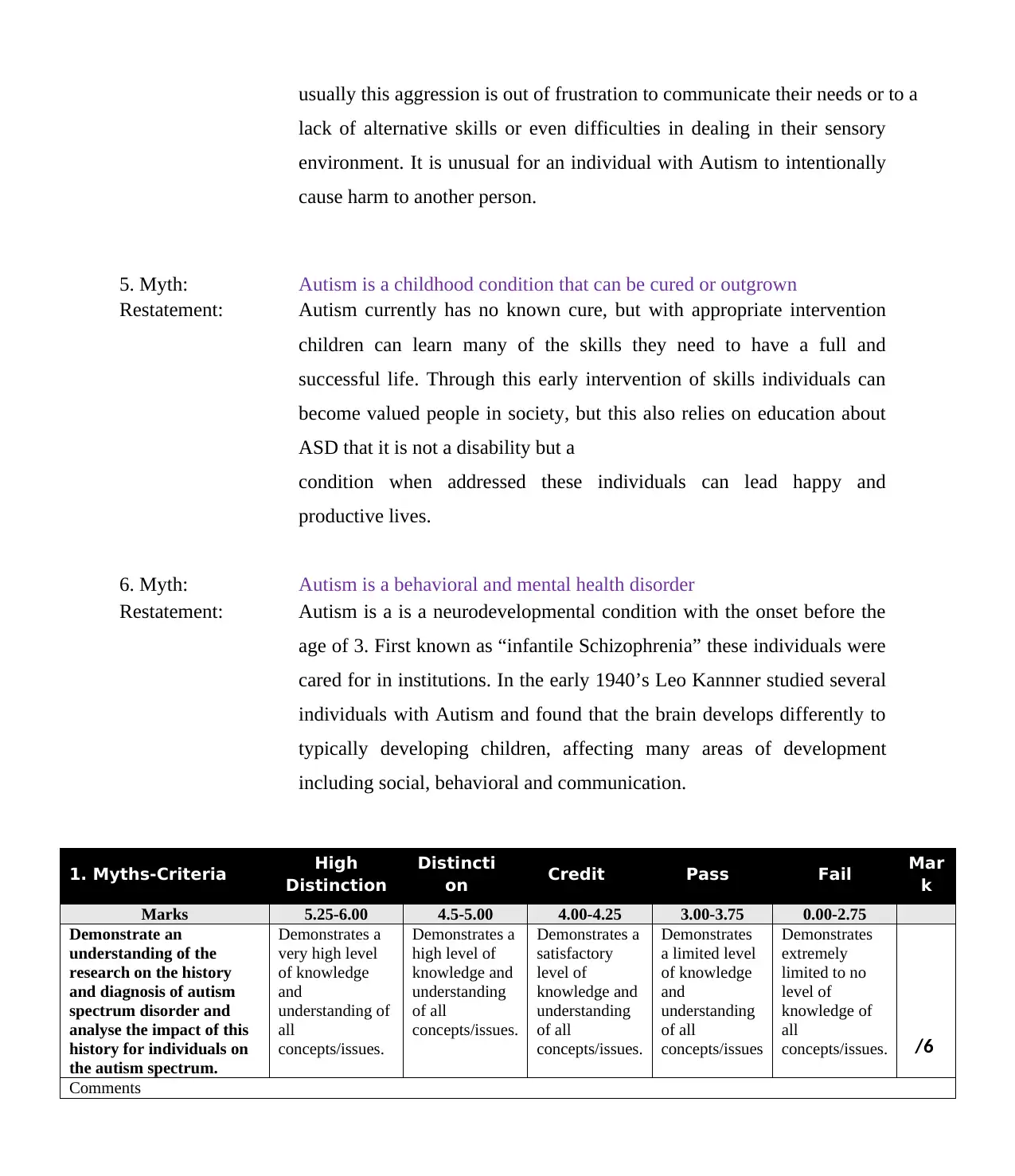
usually this aggression is out of frustration to communicate their needs or to a
lack of alternative skills or even difficulties in dealing in their sensory
environment. It is unusual for an individual with Autism to intentionally
cause harm to another person.
5. Myth: Autism is a childhood condition that can be cured or outgrown
Restatement: Autism currently has no known cure, but with appropriate intervention
children can learn many of the skills they need to have a full and
successful life. Through this early intervention of skills individuals can
become valued people in society, but this also relies on education about
ASD that it is not a disability but a
condition when addressed these individuals can lead happy and
productive lives.
6. Myth: Autism is a behavioral and mental health disorder
Restatement: Autism is a is a neurodevelopmental condition with the onset before the
age of 3. First known as “infantile Schizophrenia” these individuals were
cared for in institutions. In the early 1940’s Leo Kannner studied several
individuals with Autism and found that the brain develops differently to
typically developing children, affecting many areas of development
including social, behavioral and communication.
1. Myths-Criteria High
Distinction
Distincti
on Credit Pass Fail Mar
k
Marks 5.25-6.00 4.5-5.00 4.00-4.25 3.00-3.75 0.00-2.75
Demonstrate an
understanding of the
research on the history
and diagnosis of autism
spectrum disorder and
analyse the impact of this
history for individuals on
the autism spectrum.
Demonstrates a
very high level
of knowledge
and
understanding of
all
concepts/issues.
Demonstrates a
high level of
knowledge and
understanding
of all
concepts/issues.
Demonstrates a
satisfactory
level of
knowledge and
understanding
of all
concepts/issues.
Demonstrates
a limited level
of knowledge
and
understanding
of all
concepts/issues
Demonstrates
extremely
limited to no
level of
knowledge of
all
concepts/issues. /6
Comments
lack of alternative skills or even difficulties in dealing in their sensory
environment. It is unusual for an individual with Autism to intentionally
cause harm to another person.
5. Myth: Autism is a childhood condition that can be cured or outgrown
Restatement: Autism currently has no known cure, but with appropriate intervention
children can learn many of the skills they need to have a full and
successful life. Through this early intervention of skills individuals can
become valued people in society, but this also relies on education about
ASD that it is not a disability but a
condition when addressed these individuals can lead happy and
productive lives.
6. Myth: Autism is a behavioral and mental health disorder
Restatement: Autism is a is a neurodevelopmental condition with the onset before the
age of 3. First known as “infantile Schizophrenia” these individuals were
cared for in institutions. In the early 1940’s Leo Kannner studied several
individuals with Autism and found that the brain develops differently to
typically developing children, affecting many areas of development
including social, behavioral and communication.
1. Myths-Criteria High
Distinction
Distincti
on Credit Pass Fail Mar
k
Marks 5.25-6.00 4.5-5.00 4.00-4.25 3.00-3.75 0.00-2.75
Demonstrate an
understanding of the
research on the history
and diagnosis of autism
spectrum disorder and
analyse the impact of this
history for individuals on
the autism spectrum.
Demonstrates a
very high level
of knowledge
and
understanding of
all
concepts/issues.
Demonstrates a
high level of
knowledge and
understanding
of all
concepts/issues.
Demonstrates a
satisfactory
level of
knowledge and
understanding
of all
concepts/issues.
Demonstrates
a limited level
of knowledge
and
understanding
of all
concepts/issues
Demonstrates
extremely
limited to no
level of
knowledge of
all
concepts/issues. /6
Comments
⊘ This is a preview!⊘
Do you want full access?
Subscribe today to unlock all pages.

Trusted by 1+ million students worldwide
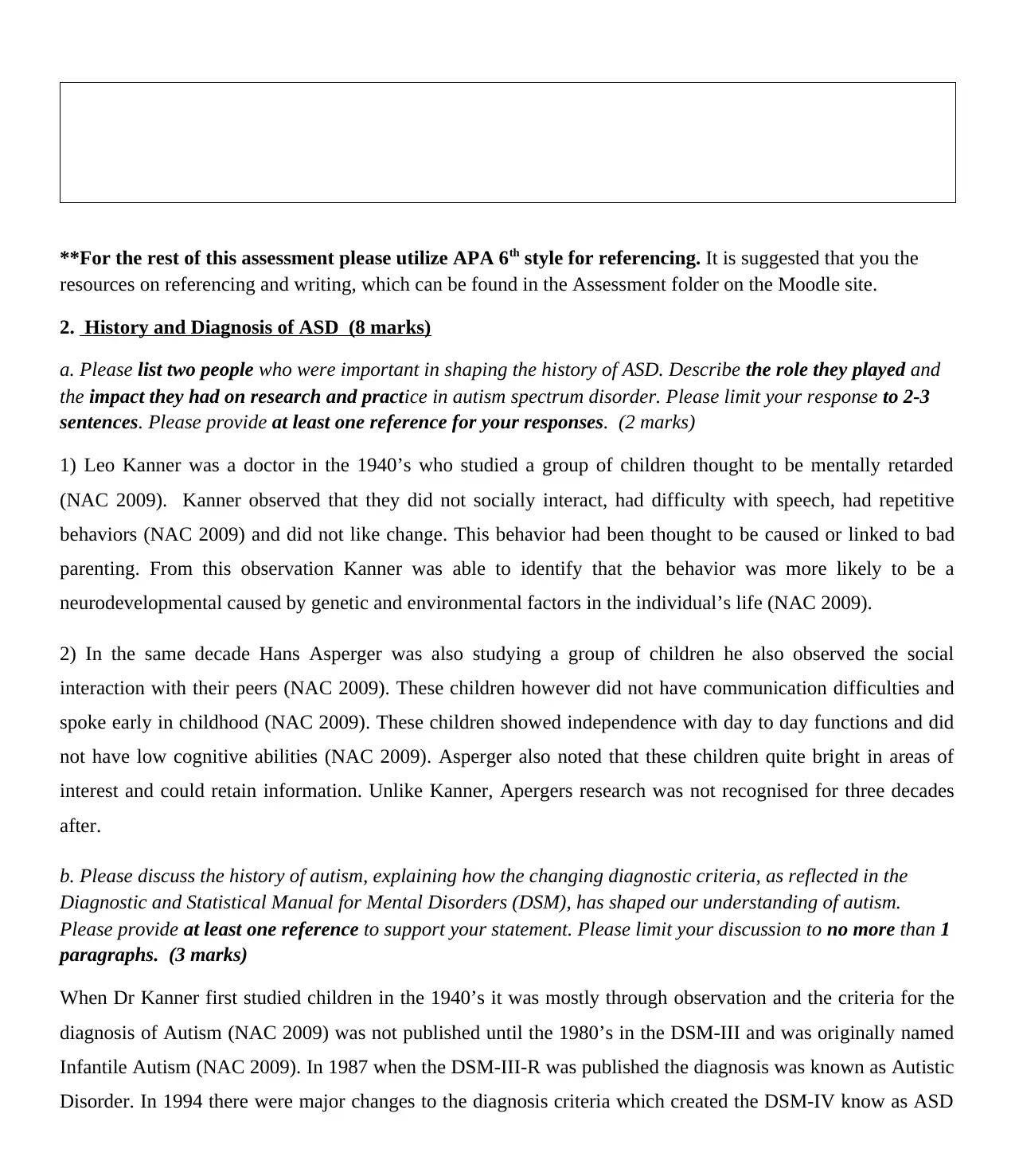
**For the rest of this assessment please utilize APA 6th style for referencing. It is suggested that you the
resources on referencing and writing, which can be found in the Assessment folder on the Moodle site.
2. History and Diagnosis of ASD (8 marks)
a. Please list two people who were important in shaping the history of ASD. Describe the role they played and
the impact they had on research and practice in autism spectrum disorder. Please limit your response to 2-3
sentences. Please provide at least one reference for your responses. (2 marks)
1) Leo Kanner was a doctor in the 1940’s who studied a group of children thought to be mentally retarded
(NAC 2009). Kanner observed that they did not socially interact, had difficulty with speech, had repetitive
behaviors (NAC 2009) and did not like change. This behavior had been thought to be caused or linked to bad
parenting. From this observation Kanner was able to identify that the behavior was more likely to be a
neurodevelopmental caused by genetic and environmental factors in the individual’s life (NAC 2009).
2) In the same decade Hans Asperger was also studying a group of children he also observed the social
interaction with their peers (NAC 2009). These children however did not have communication difficulties and
spoke early in childhood (NAC 2009). These children showed independence with day to day functions and did
not have low cognitive abilities (NAC 2009). Asperger also noted that these children quite bright in areas of
interest and could retain information. Unlike Kanner, Apergers research was not recognised for three decades
after.
b. Please discuss the history of autism, explaining how the changing diagnostic criteria, as reflected in the
Diagnostic and Statistical Manual for Mental Disorders (DSM), has shaped our understanding of autism.
Please provide at least one reference to support your statement. Please limit your discussion to no more than 1
paragraphs. (3 marks)
When Dr Kanner first studied children in the 1940’s it was mostly through observation and the criteria for the
diagnosis of Autism (NAC 2009) was not published until the 1980’s in the DSM-III and was originally named
Infantile Autism (NAC 2009). In 1987 when the DSM-III-R was published the diagnosis was known as Autistic
Disorder. In 1994 there were major changes to the diagnosis criteria which created the DSM-IV know as ASD
resources on referencing and writing, which can be found in the Assessment folder on the Moodle site.
2. History and Diagnosis of ASD (8 marks)
a. Please list two people who were important in shaping the history of ASD. Describe the role they played and
the impact they had on research and practice in autism spectrum disorder. Please limit your response to 2-3
sentences. Please provide at least one reference for your responses. (2 marks)
1) Leo Kanner was a doctor in the 1940’s who studied a group of children thought to be mentally retarded
(NAC 2009). Kanner observed that they did not socially interact, had difficulty with speech, had repetitive
behaviors (NAC 2009) and did not like change. This behavior had been thought to be caused or linked to bad
parenting. From this observation Kanner was able to identify that the behavior was more likely to be a
neurodevelopmental caused by genetic and environmental factors in the individual’s life (NAC 2009).
2) In the same decade Hans Asperger was also studying a group of children he also observed the social
interaction with their peers (NAC 2009). These children however did not have communication difficulties and
spoke early in childhood (NAC 2009). These children showed independence with day to day functions and did
not have low cognitive abilities (NAC 2009). Asperger also noted that these children quite bright in areas of
interest and could retain information. Unlike Kanner, Apergers research was not recognised for three decades
after.
b. Please discuss the history of autism, explaining how the changing diagnostic criteria, as reflected in the
Diagnostic and Statistical Manual for Mental Disorders (DSM), has shaped our understanding of autism.
Please provide at least one reference to support your statement. Please limit your discussion to no more than 1
paragraphs. (3 marks)
When Dr Kanner first studied children in the 1940’s it was mostly through observation and the criteria for the
diagnosis of Autism (NAC 2009) was not published until the 1980’s in the DSM-III and was originally named
Infantile Autism (NAC 2009). In 1987 when the DSM-III-R was published the diagnosis was known as Autistic
Disorder. In 1994 there were major changes to the diagnosis criteria which created the DSM-IV know as ASD
Paraphrase This Document
Need a fresh take? Get an instant paraphrase of this document with our AI Paraphraser
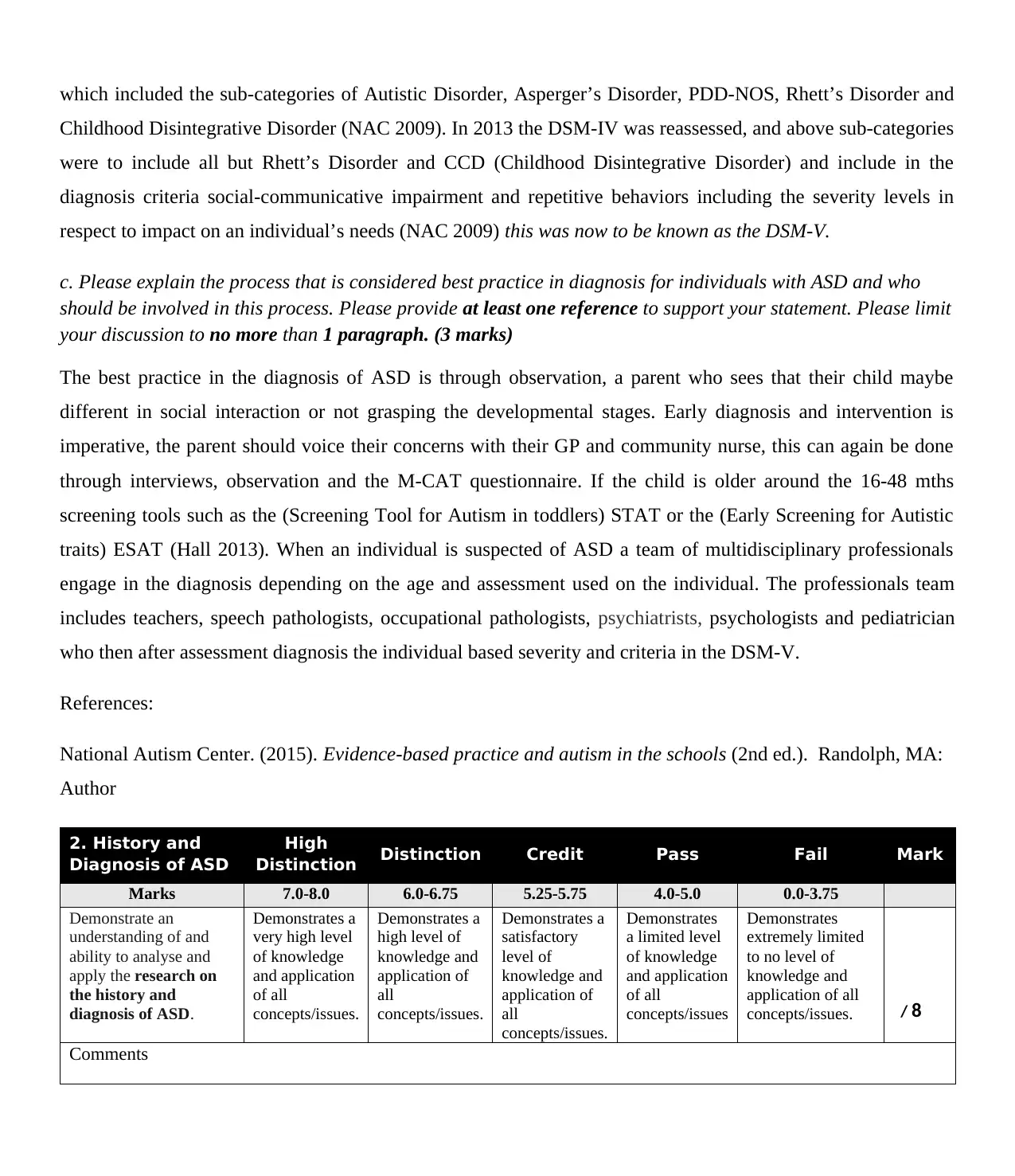
which included the sub-categories of Autistic Disorder, Asperger’s Disorder, PDD-NOS, Rhett’s Disorder and
Childhood Disintegrative Disorder (NAC 2009). In 2013 the DSM-IV was reassessed, and above sub-categories
were to include all but Rhett’s Disorder and CCD (Childhood Disintegrative Disorder) and include in the
diagnosis criteria social-communicative impairment and repetitive behaviors including the severity levels in
respect to impact on an individual’s needs (NAC 2009) this was now to be known as the DSM-V.
c. Please explain the process that is considered best practice in diagnosis for individuals with ASD and who
should be involved in this process. Please provide at least one reference to support your statement. Please limit
your discussion to no more than 1 paragraph. (3 marks)
The best practice in the diagnosis of ASD is through observation, a parent who sees that their child maybe
different in social interaction or not grasping the developmental stages. Early diagnosis and intervention is
imperative, the parent should voice their concerns with their GP and community nurse, this can again be done
through interviews, observation and the M-CAT questionnaire. If the child is older around the 16-48 mths
screening tools such as the (Screening Tool for Autism in toddlers) STAT or the (Early Screening for Autistic
traits) ESAT (Hall 2013). When an individual is suspected of ASD a team of multidisciplinary professionals
engage in the diagnosis depending on the age and assessment used on the individual. The professionals team
includes teachers, speech pathologists, occupational pathologists, psychiatrists, psychologists and pediatrician
who then after assessment diagnosis the individual based severity and criteria in the DSM-V.
References:
National Autism Center. (2015). Evidence-based practice and autism in the schools (2nd ed.). Randolph, MA:
Author
2. History and
Diagnosis of ASD
High
Distinction Distinction Credit Pass Fail Mark
Marks 7.0-8.0 6.0-6.75 5.25-5.75 4.0-5.0 0.0-3.75
Demonstrate an
understanding of and
ability to analyse and
apply the research on
the history and
diagnosis of ASD.
Demonstrates a
very high level
of knowledge
and application
of all
concepts/issues.
Demonstrates a
high level of
knowledge and
application of
all
concepts/issues.
Demonstrates a
satisfactory
level of
knowledge and
application of
all
concepts/issues.
Demonstrates
a limited level
of knowledge
and application
of all
concepts/issues
Demonstrates
extremely limited
to no level of
knowledge and
application of all
concepts/issues. / 8
Comments
Childhood Disintegrative Disorder (NAC 2009). In 2013 the DSM-IV was reassessed, and above sub-categories
were to include all but Rhett’s Disorder and CCD (Childhood Disintegrative Disorder) and include in the
diagnosis criteria social-communicative impairment and repetitive behaviors including the severity levels in
respect to impact on an individual’s needs (NAC 2009) this was now to be known as the DSM-V.
c. Please explain the process that is considered best practice in diagnosis for individuals with ASD and who
should be involved in this process. Please provide at least one reference to support your statement. Please limit
your discussion to no more than 1 paragraph. (3 marks)
The best practice in the diagnosis of ASD is through observation, a parent who sees that their child maybe
different in social interaction or not grasping the developmental stages. Early diagnosis and intervention is
imperative, the parent should voice their concerns with their GP and community nurse, this can again be done
through interviews, observation and the M-CAT questionnaire. If the child is older around the 16-48 mths
screening tools such as the (Screening Tool for Autism in toddlers) STAT or the (Early Screening for Autistic
traits) ESAT (Hall 2013). When an individual is suspected of ASD a team of multidisciplinary professionals
engage in the diagnosis depending on the age and assessment used on the individual. The professionals team
includes teachers, speech pathologists, occupational pathologists, psychiatrists, psychologists and pediatrician
who then after assessment diagnosis the individual based severity and criteria in the DSM-V.
References:
National Autism Center. (2015). Evidence-based practice and autism in the schools (2nd ed.). Randolph, MA:
Author
2. History and
Diagnosis of ASD
High
Distinction Distinction Credit Pass Fail Mark
Marks 7.0-8.0 6.0-6.75 5.25-5.75 4.0-5.0 0.0-3.75
Demonstrate an
understanding of and
ability to analyse and
apply the research on
the history and
diagnosis of ASD.
Demonstrates a
very high level
of knowledge
and application
of all
concepts/issues.
Demonstrates a
high level of
knowledge and
application of
all
concepts/issues.
Demonstrates a
satisfactory
level of
knowledge and
application of
all
concepts/issues.
Demonstrates
a limited level
of knowledge
and application
of all
concepts/issues
Demonstrates
extremely limited
to no level of
knowledge and
application of all
concepts/issues. / 8
Comments
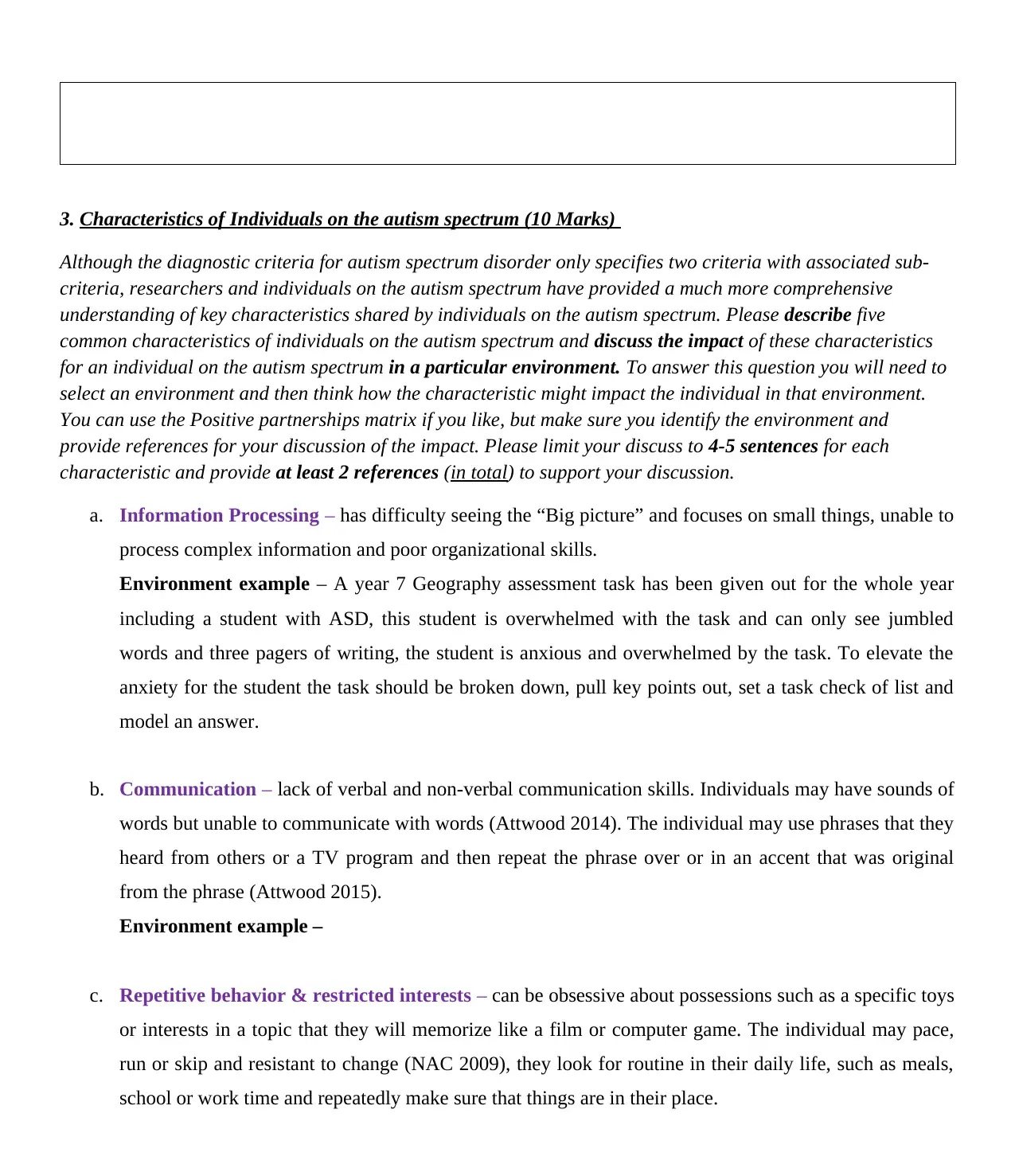
3. Characteristics of Individuals on the autism spectrum (10 Marks)
Although the diagnostic criteria for autism spectrum disorder only specifies two criteria with associated sub-
criteria, researchers and individuals on the autism spectrum have provided a much more comprehensive
understanding of key characteristics shared by individuals on the autism spectrum. Please describe five
common characteristics of individuals on the autism spectrum and discuss the impact of these characteristics
for an individual on the autism spectrum in a particular environment. To answer this question you will need to
select an environment and then think how the characteristic might impact the individual in that environment.
You can use the Positive partnerships matrix if you like, but make sure you identify the environment and
provide references for your discussion of the impact. Please limit your discuss to 4-5 sentences for each
characteristic and provide at least 2 references (in total) to support your discussion.
a. Information Processing – has difficulty seeing the “Big picture” and focuses on small things, unable to
process complex information and poor organizational skills.
Environment example – A year 7 Geography assessment task has been given out for the whole year
including a student with ASD, this student is overwhelmed with the task and can only see jumbled
words and three pagers of writing, the student is anxious and overwhelmed by the task. To elevate the
anxiety for the student the task should be broken down, pull key points out, set a task check of list and
model an answer.
b. Communication – lack of verbal and non-verbal communication skills. Individuals may have sounds of
words but unable to communicate with words (Attwood 2014). The individual may use phrases that they
heard from others or a TV program and then repeat the phrase over or in an accent that was original
from the phrase (Attwood 2015).
Environment example –
c. Repetitive behavior & restricted interests – can be obsessive about possessions such as a specific toys
or interests in a topic that they will memorize like a film or computer game. The individual may pace,
run or skip and resistant to change (NAC 2009), they look for routine in their daily life, such as meals,
school or work time and repeatedly make sure that things are in their place.
Although the diagnostic criteria for autism spectrum disorder only specifies two criteria with associated sub-
criteria, researchers and individuals on the autism spectrum have provided a much more comprehensive
understanding of key characteristics shared by individuals on the autism spectrum. Please describe five
common characteristics of individuals on the autism spectrum and discuss the impact of these characteristics
for an individual on the autism spectrum in a particular environment. To answer this question you will need to
select an environment and then think how the characteristic might impact the individual in that environment.
You can use the Positive partnerships matrix if you like, but make sure you identify the environment and
provide references for your discussion of the impact. Please limit your discuss to 4-5 sentences for each
characteristic and provide at least 2 references (in total) to support your discussion.
a. Information Processing – has difficulty seeing the “Big picture” and focuses on small things, unable to
process complex information and poor organizational skills.
Environment example – A year 7 Geography assessment task has been given out for the whole year
including a student with ASD, this student is overwhelmed with the task and can only see jumbled
words and three pagers of writing, the student is anxious and overwhelmed by the task. To elevate the
anxiety for the student the task should be broken down, pull key points out, set a task check of list and
model an answer.
b. Communication – lack of verbal and non-verbal communication skills. Individuals may have sounds of
words but unable to communicate with words (Attwood 2014). The individual may use phrases that they
heard from others or a TV program and then repeat the phrase over or in an accent that was original
from the phrase (Attwood 2015).
Environment example –
c. Repetitive behavior & restricted interests – can be obsessive about possessions such as a specific toys
or interests in a topic that they will memorize like a film or computer game. The individual may pace,
run or skip and resistant to change (NAC 2009), they look for routine in their daily life, such as meals,
school or work time and repeatedly make sure that things are in their place.
⊘ This is a preview!⊘
Do you want full access?
Subscribe today to unlock all pages.

Trusted by 1+ million students worldwide
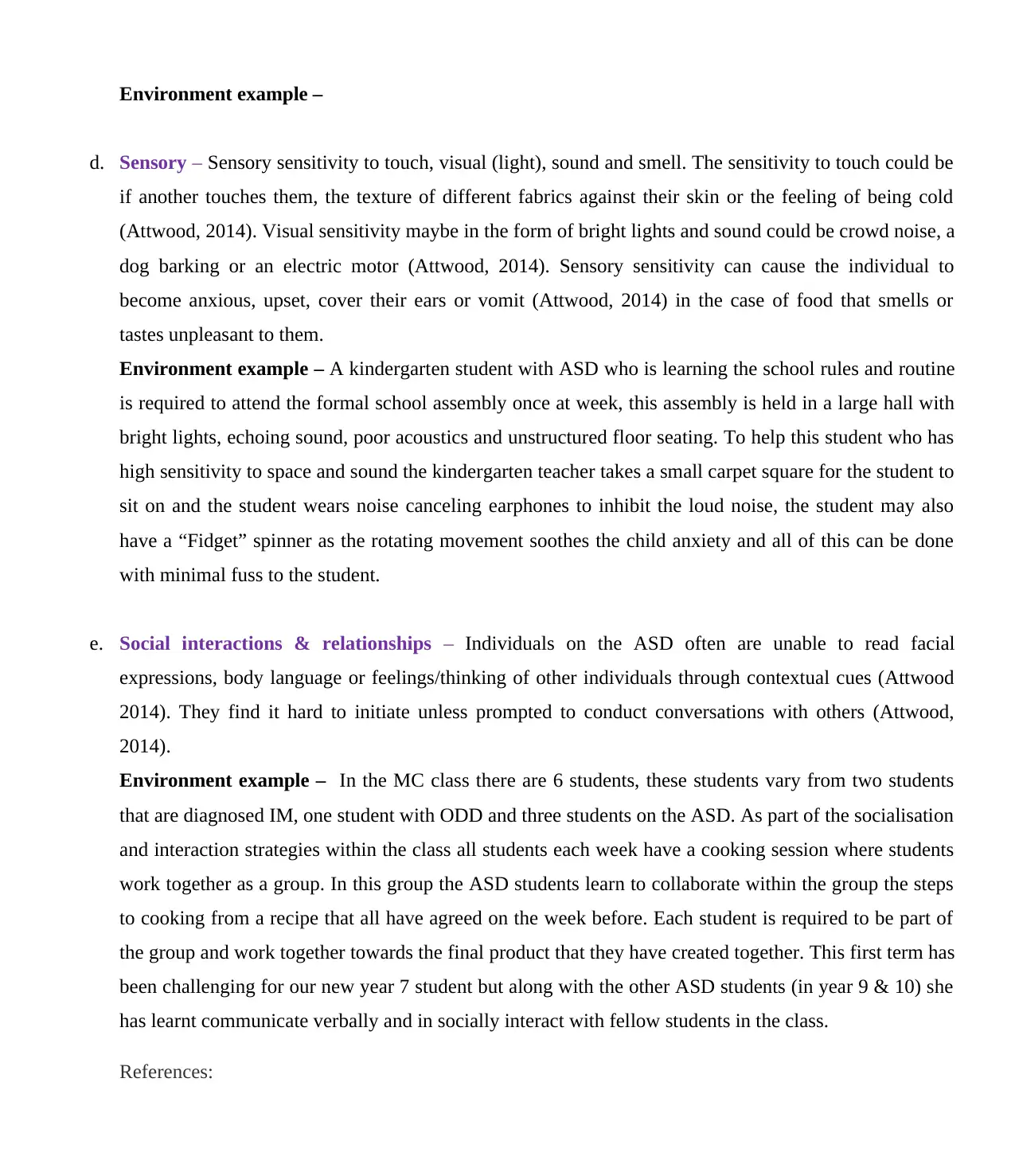
Environment example –
d. Sensory – Sensory sensitivity to touch, visual (light), sound and smell. The sensitivity to touch could be
if another touches them, the texture of different fabrics against their skin or the feeling of being cold
(Attwood, 2014). Visual sensitivity maybe in the form of bright lights and sound could be crowd noise, a
dog barking or an electric motor (Attwood, 2014). Sensory sensitivity can cause the individual to
become anxious, upset, cover their ears or vomit (Attwood, 2014) in the case of food that smells or
tastes unpleasant to them.
Environment example – A kindergarten student with ASD who is learning the school rules and routine
is required to attend the formal school assembly once at week, this assembly is held in a large hall with
bright lights, echoing sound, poor acoustics and unstructured floor seating. To help this student who has
high sensitivity to space and sound the kindergarten teacher takes a small carpet square for the student to
sit on and the student wears noise canceling earphones to inhibit the loud noise, the student may also
have a “Fidget” spinner as the rotating movement soothes the child anxiety and all of this can be done
with minimal fuss to the student.
e. Social interactions & relationships – Individuals on the ASD often are unable to read facial
expressions, body language or feelings/thinking of other individuals through contextual cues (Attwood
2014). They find it hard to initiate unless prompted to conduct conversations with others (Attwood,
2014).
Environment example – In the MC class there are 6 students, these students vary from two students
that are diagnosed IM, one student with ODD and three students on the ASD. As part of the socialisation
and interaction strategies within the class all students each week have a cooking session where students
work together as a group. In this group the ASD students learn to collaborate within the group the steps
to cooking from a recipe that all have agreed on the week before. Each student is required to be part of
the group and work together towards the final product that they have created together. This first term has
been challenging for our new year 7 student but along with the other ASD students (in year 9 & 10) she
has learnt communicate verbally and in socially interact with fellow students in the class.
References:
d. Sensory – Sensory sensitivity to touch, visual (light), sound and smell. The sensitivity to touch could be
if another touches them, the texture of different fabrics against their skin or the feeling of being cold
(Attwood, 2014). Visual sensitivity maybe in the form of bright lights and sound could be crowd noise, a
dog barking or an electric motor (Attwood, 2014). Sensory sensitivity can cause the individual to
become anxious, upset, cover their ears or vomit (Attwood, 2014) in the case of food that smells or
tastes unpleasant to them.
Environment example – A kindergarten student with ASD who is learning the school rules and routine
is required to attend the formal school assembly once at week, this assembly is held in a large hall with
bright lights, echoing sound, poor acoustics and unstructured floor seating. To help this student who has
high sensitivity to space and sound the kindergarten teacher takes a small carpet square for the student to
sit on and the student wears noise canceling earphones to inhibit the loud noise, the student may also
have a “Fidget” spinner as the rotating movement soothes the child anxiety and all of this can be done
with minimal fuss to the student.
e. Social interactions & relationships – Individuals on the ASD often are unable to read facial
expressions, body language or feelings/thinking of other individuals through contextual cues (Attwood
2014). They find it hard to initiate unless prompted to conduct conversations with others (Attwood,
2014).
Environment example – In the MC class there are 6 students, these students vary from two students
that are diagnosed IM, one student with ODD and three students on the ASD. As part of the socialisation
and interaction strategies within the class all students each week have a cooking session where students
work together as a group. In this group the ASD students learn to collaborate within the group the steps
to cooking from a recipe that all have agreed on the week before. Each student is required to be part of
the group and work together towards the final product that they have created together. This first term has
been challenging for our new year 7 student but along with the other ASD students (in year 9 & 10) she
has learnt communicate verbally and in socially interact with fellow students in the class.
References:
Paraphrase This Document
Need a fresh take? Get an instant paraphrase of this document with our AI Paraphraser
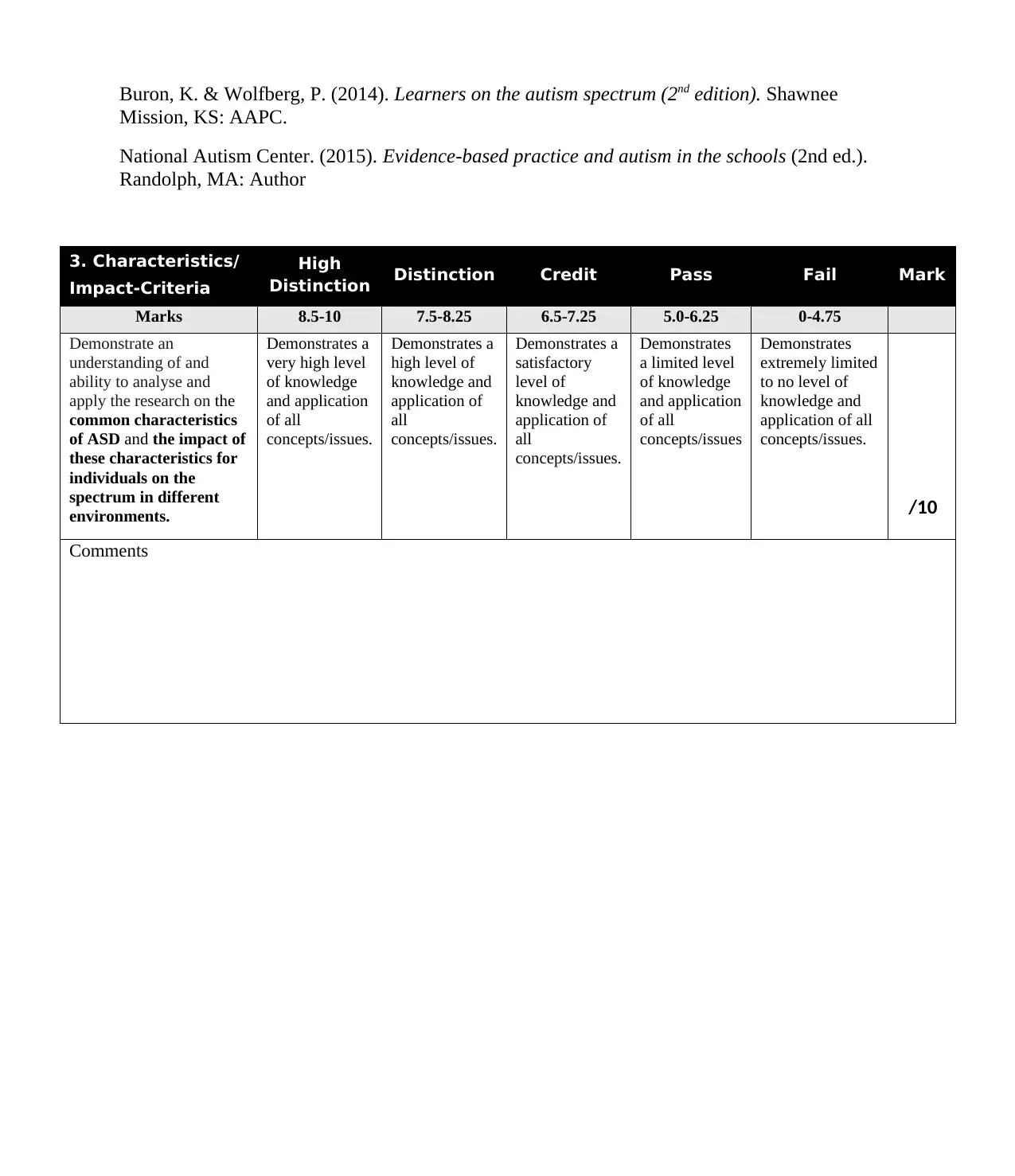
Buron, K. & Wolfberg, P. (2014). Learners on the autism spectrum (2nd edition). Shawnee
Mission, KS: AAPC.
National Autism Center. (2015). Evidence-based practice and autism in the schools (2nd ed.).
Randolph, MA: Author
3. Characteristics/
Impact-Criteria
High
Distinction Distinction Credit Pass Fail Mark
Marks 8.5-10 7.5-8.25 6.5-7.25 5.0-6.25 0-4.75
Demonstrate an
understanding of and
ability to analyse and
apply the research on the
common characteristics
of ASD and the impact of
these characteristics for
individuals on the
spectrum in different
environments.
Demonstrates a
very high level
of knowledge
and application
of all
concepts/issues.
Demonstrates a
high level of
knowledge and
application of
all
concepts/issues.
Demonstrates a
satisfactory
level of
knowledge and
application of
all
concepts/issues.
Demonstrates
a limited level
of knowledge
and application
of all
concepts/issues
Demonstrates
extremely limited
to no level of
knowledge and
application of all
concepts/issues.
/10
Comments
Mission, KS: AAPC.
National Autism Center. (2015). Evidence-based practice and autism in the schools (2nd ed.).
Randolph, MA: Author
3. Characteristics/
Impact-Criteria
High
Distinction Distinction Credit Pass Fail Mark
Marks 8.5-10 7.5-8.25 6.5-7.25 5.0-6.25 0-4.75
Demonstrate an
understanding of and
ability to analyse and
apply the research on the
common characteristics
of ASD and the impact of
these characteristics for
individuals on the
spectrum in different
environments.
Demonstrates a
very high level
of knowledge
and application
of all
concepts/issues.
Demonstrates a
high level of
knowledge and
application of
all
concepts/issues.
Demonstrates a
satisfactory
level of
knowledge and
application of
all
concepts/issues.
Demonstrates
a limited level
of knowledge
and application
of all
concepts/issues
Demonstrates
extremely limited
to no level of
knowledge and
application of all
concepts/issues.
/10
Comments
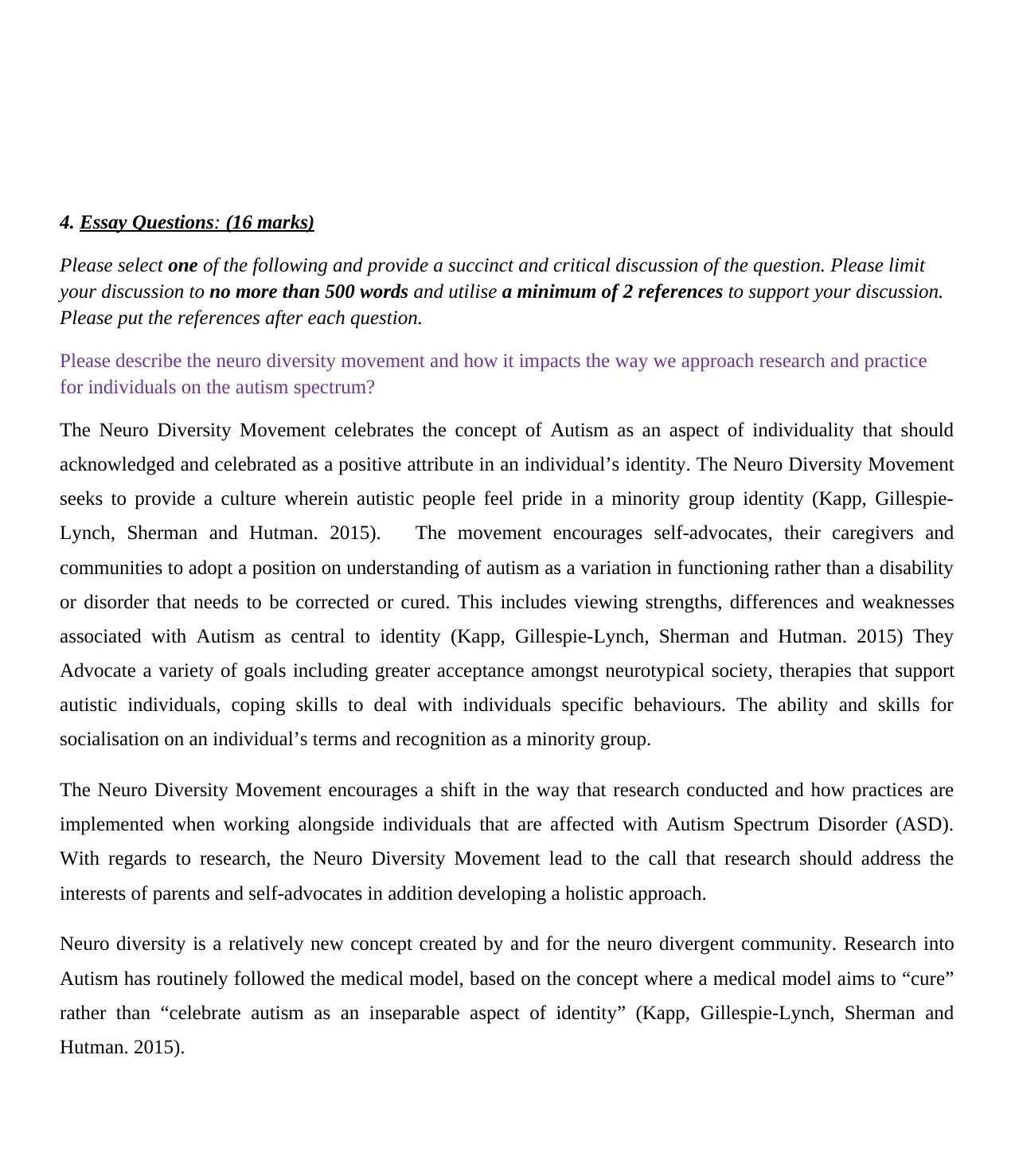
4. Essay Questions: (16 marks)
Please select one of the following and provide a succinct and critical discussion of the question. Please limit
your discussion to no more than 500 words and utilise a minimum of 2 references to support your discussion.
Please put the references after each question.
Please describe the neuro diversity movement and how it impacts the way we approach research and practice
for individuals on the autism spectrum?
The Neuro Diversity Movement celebrates the concept of Autism as an aspect of individuality that should
acknowledged and celebrated as a positive attribute in an individual’s identity. The Neuro Diversity Movement
seeks to provide a culture wherein autistic people feel pride in a minority group identity (Kapp, Gillespie-
Lynch, Sherman and Hutman. 2015). The movement encourages self-advocates, their caregivers and
communities to adopt a position on understanding of autism as a variation in functioning rather than a disability
or disorder that needs to be corrected or cured. This includes viewing strengths, differences and weaknesses
associated with Autism as central to identity (Kapp, Gillespie-Lynch, Sherman and Hutman. 2015) They
Advocate a variety of goals including greater acceptance amongst neurotypical society, therapies that support
autistic individuals, coping skills to deal with individuals specific behaviours. The ability and skills for
socialisation on an individual’s terms and recognition as a minority group.
The Neuro Diversity Movement encourages a shift in the way that research conducted and how practices are
implemented when working alongside individuals that are affected with Autism Spectrum Disorder (ASD).
With regards to research, the Neuro Diversity Movement lead to the call that research should address the
interests of parents and self-advocates in addition developing a holistic approach.
Neuro diversity is a relatively new concept created by and for the neuro divergent community. Research into
Autism has routinely followed the medical model, based on the concept where a medical model aims to “cure”
rather than “celebrate autism as an inseparable aspect of identity” (Kapp, Gillespie-Lynch, Sherman and
Hutman. 2015).
Please select one of the following and provide a succinct and critical discussion of the question. Please limit
your discussion to no more than 500 words and utilise a minimum of 2 references to support your discussion.
Please put the references after each question.
Please describe the neuro diversity movement and how it impacts the way we approach research and practice
for individuals on the autism spectrum?
The Neuro Diversity Movement celebrates the concept of Autism as an aspect of individuality that should
acknowledged and celebrated as a positive attribute in an individual’s identity. The Neuro Diversity Movement
seeks to provide a culture wherein autistic people feel pride in a minority group identity (Kapp, Gillespie-
Lynch, Sherman and Hutman. 2015). The movement encourages self-advocates, their caregivers and
communities to adopt a position on understanding of autism as a variation in functioning rather than a disability
or disorder that needs to be corrected or cured. This includes viewing strengths, differences and weaknesses
associated with Autism as central to identity (Kapp, Gillespie-Lynch, Sherman and Hutman. 2015) They
Advocate a variety of goals including greater acceptance amongst neurotypical society, therapies that support
autistic individuals, coping skills to deal with individuals specific behaviours. The ability and skills for
socialisation on an individual’s terms and recognition as a minority group.
The Neuro Diversity Movement encourages a shift in the way that research conducted and how practices are
implemented when working alongside individuals that are affected with Autism Spectrum Disorder (ASD).
With regards to research, the Neuro Diversity Movement lead to the call that research should address the
interests of parents and self-advocates in addition developing a holistic approach.
Neuro diversity is a relatively new concept created by and for the neuro divergent community. Research into
Autism has routinely followed the medical model, based on the concept where a medical model aims to “cure”
rather than “celebrate autism as an inseparable aspect of identity” (Kapp, Gillespie-Lynch, Sherman and
Hutman. 2015).
⊘ This is a preview!⊘
Do you want full access?
Subscribe today to unlock all pages.

Trusted by 1+ million students worldwide
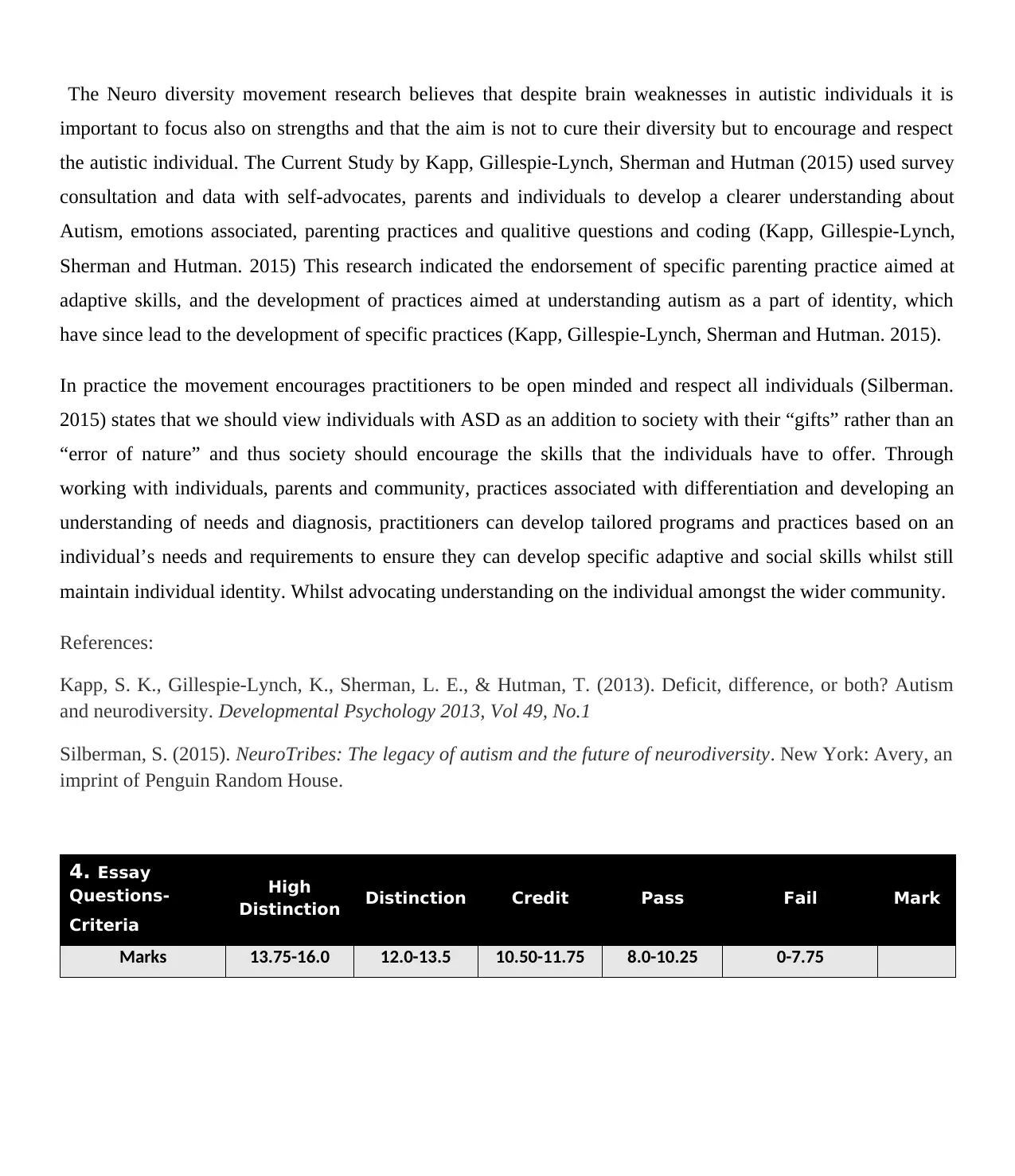
The Neuro diversity movement research believes that despite brain weaknesses in autistic individuals it is
important to focus also on strengths and that the aim is not to cure their diversity but to encourage and respect
the autistic individual. The Current Study by Kapp, Gillespie-Lynch, Sherman and Hutman (2015) used survey
consultation and data with self-advocates, parents and individuals to develop a clearer understanding about
Autism, emotions associated, parenting practices and qualitive questions and coding (Kapp, Gillespie-Lynch,
Sherman and Hutman. 2015) This research indicated the endorsement of specific parenting practice aimed at
adaptive skills, and the development of practices aimed at understanding autism as a part of identity, which
have since lead to the development of specific practices (Kapp, Gillespie-Lynch, Sherman and Hutman. 2015).
In practice the movement encourages practitioners to be open minded and respect all individuals (Silberman.
2015) states that we should view individuals with ASD as an addition to society with their “gifts” rather than an
“error of nature” and thus society should encourage the skills that the individuals have to offer. Through
working with individuals, parents and community, practices associated with differentiation and developing an
understanding of needs and diagnosis, practitioners can develop tailored programs and practices based on an
individual’s needs and requirements to ensure they can develop specific adaptive and social skills whilst still
maintain individual identity. Whilst advocating understanding on the individual amongst the wider community.
References:
Kapp, S. K., Gillespie-Lynch, K., Sherman, L. E., & Hutman, T. (2013). Deficit, difference, or both? Autism
and neurodiversity. Developmental Psychology 2013, Vol 49, No.1
Silberman, S. (2015). NeuroTribes: The legacy of autism and the future of neurodiversity. New York: Avery, an
imprint of Penguin Random House.
4. Essay
Questions-
Criteria
High
Distinction Distinction Credit Pass Fail Mark
Marks 13.75-16.0 12.0-13.5 10.50-11.75 8.0-10.25 0-7.75
important to focus also on strengths and that the aim is not to cure their diversity but to encourage and respect
the autistic individual. The Current Study by Kapp, Gillespie-Lynch, Sherman and Hutman (2015) used survey
consultation and data with self-advocates, parents and individuals to develop a clearer understanding about
Autism, emotions associated, parenting practices and qualitive questions and coding (Kapp, Gillespie-Lynch,
Sherman and Hutman. 2015) This research indicated the endorsement of specific parenting practice aimed at
adaptive skills, and the development of practices aimed at understanding autism as a part of identity, which
have since lead to the development of specific practices (Kapp, Gillespie-Lynch, Sherman and Hutman. 2015).
In practice the movement encourages practitioners to be open minded and respect all individuals (Silberman.
2015) states that we should view individuals with ASD as an addition to society with their “gifts” rather than an
“error of nature” and thus society should encourage the skills that the individuals have to offer. Through
working with individuals, parents and community, practices associated with differentiation and developing an
understanding of needs and diagnosis, practitioners can develop tailored programs and practices based on an
individual’s needs and requirements to ensure they can develop specific adaptive and social skills whilst still
maintain individual identity. Whilst advocating understanding on the individual amongst the wider community.
References:
Kapp, S. K., Gillespie-Lynch, K., Sherman, L. E., & Hutman, T. (2013). Deficit, difference, or both? Autism
and neurodiversity. Developmental Psychology 2013, Vol 49, No.1
Silberman, S. (2015). NeuroTribes: The legacy of autism and the future of neurodiversity. New York: Avery, an
imprint of Penguin Random House.
4. Essay
Questions-
Criteria
High
Distinction Distinction Credit Pass Fail Mark
Marks 13.75-16.0 12.0-13.5 10.50-11.75 8.0-10.25 0-7.75
Paraphrase This Document
Need a fresh take? Get an instant paraphrase of this document with our AI Paraphraser
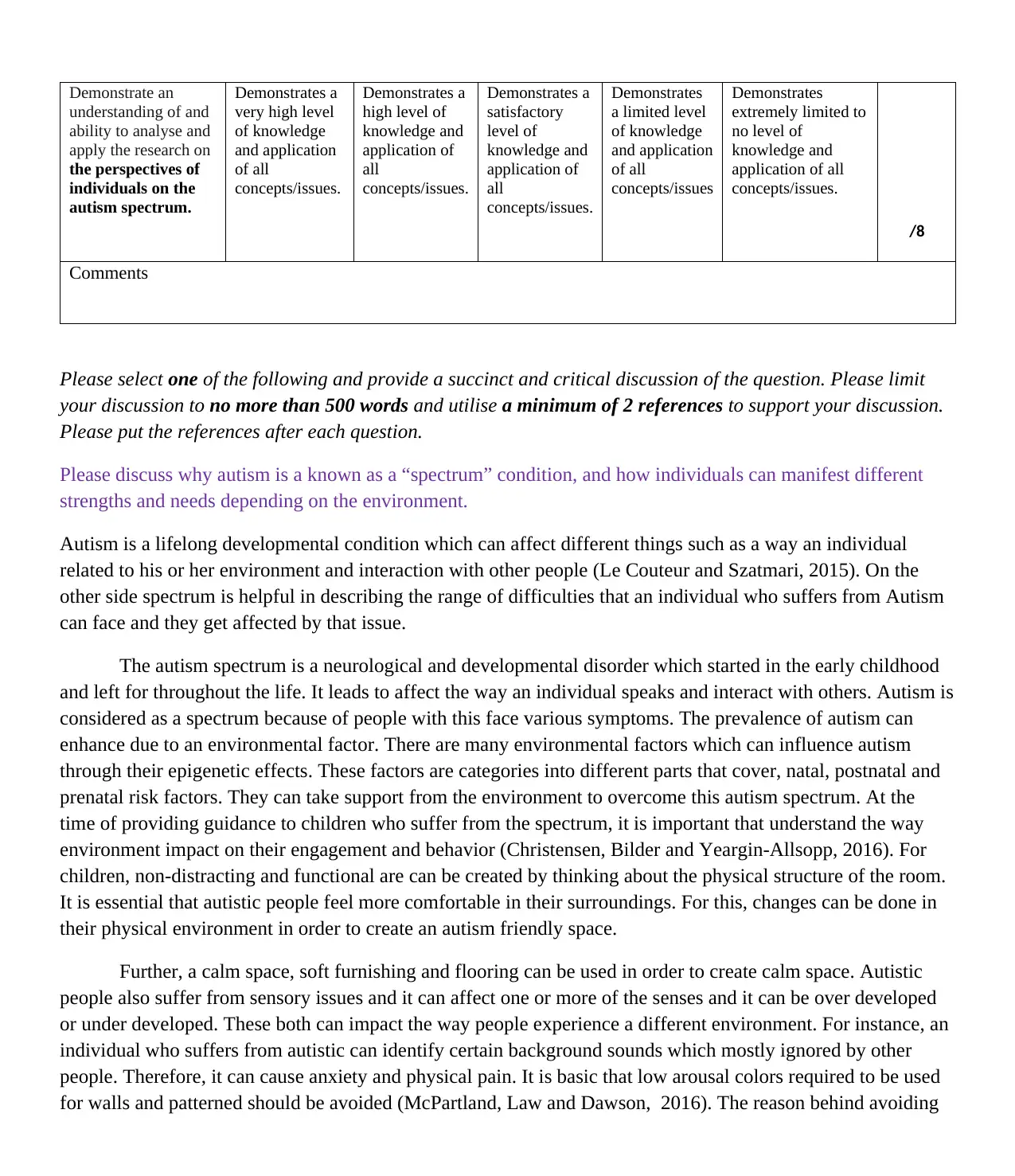
Demonstrate an
understanding of and
ability to analyse and
apply the research on
the perspectives of
individuals on the
autism spectrum.
Demonstrates a
very high level
of knowledge
and application
of all
concepts/issues.
Demonstrates a
high level of
knowledge and
application of
all
concepts/issues.
Demonstrates a
satisfactory
level of
knowledge and
application of
all
concepts/issues.
Demonstrates
a limited level
of knowledge
and application
of all
concepts/issues
Demonstrates
extremely limited to
no level of
knowledge and
application of all
concepts/issues.
/8
Comments
Please select one of the following and provide a succinct and critical discussion of the question. Please limit
your discussion to no more than 500 words and utilise a minimum of 2 references to support your discussion.
Please put the references after each question.
Please discuss why autism is a known as a “spectrum” condition, and how individuals can manifest different
strengths and needs depending on the environment.
Autism is a lifelong developmental condition which can affect different things such as a way an individual
related to his or her environment and interaction with other people (Le Couteur and Szatmari, 2015). On the
other side spectrum is helpful in describing the range of difficulties that an individual who suffers from Autism
can face and they get affected by that issue.
The autism spectrum is a neurological and developmental disorder which started in the early childhood
and left for throughout the life. It leads to affect the way an individual speaks and interact with others. Autism is
considered as a spectrum because of people with this face various symptoms. The prevalence of autism can
enhance due to an environmental factor. There are many environmental factors which can influence autism
through their epigenetic effects. These factors are categories into different parts that cover, natal, postnatal and
prenatal risk factors. They can take support from the environment to overcome this autism spectrum. At the
time of providing guidance to children who suffer from the spectrum, it is important that understand the way
environment impact on their engagement and behavior (Christensen, Bilder and Yeargin-Allsopp, 2016). For
children, non-distracting and functional are can be created by thinking about the physical structure of the room.
It is essential that autistic people feel more comfortable in their surroundings. For this, changes can be done in
their physical environment in order to create an autism friendly space.
Further, a calm space, soft furnishing and flooring can be used in order to create calm space. Autistic
people also suffer from sensory issues and it can affect one or more of the senses and it can be over developed
or under developed. These both can impact the way people experience a different environment. For instance, an
individual who suffers from autistic can identify certain background sounds which mostly ignored by other
people. Therefore, it can cause anxiety and physical pain. It is basic that low arousal colors required to be used
for walls and patterned should be avoided (McPartland, Law and Dawson, 2016). The reason behind avoiding
understanding of and
ability to analyse and
apply the research on
the perspectives of
individuals on the
autism spectrum.
Demonstrates a
very high level
of knowledge
and application
of all
concepts/issues.
Demonstrates a
high level of
knowledge and
application of
all
concepts/issues.
Demonstrates a
satisfactory
level of
knowledge and
application of
all
concepts/issues.
Demonstrates
a limited level
of knowledge
and application
of all
concepts/issues
Demonstrates
extremely limited to
no level of
knowledge and
application of all
concepts/issues.
/8
Comments
Please select one of the following and provide a succinct and critical discussion of the question. Please limit
your discussion to no more than 500 words and utilise a minimum of 2 references to support your discussion.
Please put the references after each question.
Please discuss why autism is a known as a “spectrum” condition, and how individuals can manifest different
strengths and needs depending on the environment.
Autism is a lifelong developmental condition which can affect different things such as a way an individual
related to his or her environment and interaction with other people (Le Couteur and Szatmari, 2015). On the
other side spectrum is helpful in describing the range of difficulties that an individual who suffers from Autism
can face and they get affected by that issue.
The autism spectrum is a neurological and developmental disorder which started in the early childhood
and left for throughout the life. It leads to affect the way an individual speaks and interact with others. Autism is
considered as a spectrum because of people with this face various symptoms. The prevalence of autism can
enhance due to an environmental factor. There are many environmental factors which can influence autism
through their epigenetic effects. These factors are categories into different parts that cover, natal, postnatal and
prenatal risk factors. They can take support from the environment to overcome this autism spectrum. At the
time of providing guidance to children who suffer from the spectrum, it is important that understand the way
environment impact on their engagement and behavior (Christensen, Bilder and Yeargin-Allsopp, 2016). For
children, non-distracting and functional are can be created by thinking about the physical structure of the room.
It is essential that autistic people feel more comfortable in their surroundings. For this, changes can be done in
their physical environment in order to create an autism friendly space.
Further, a calm space, soft furnishing and flooring can be used in order to create calm space. Autistic
people also suffer from sensory issues and it can affect one or more of the senses and it can be over developed
or under developed. These both can impact the way people experience a different environment. For instance, an
individual who suffers from autistic can identify certain background sounds which mostly ignored by other
people. Therefore, it can cause anxiety and physical pain. It is basic that low arousal colors required to be used
for walls and patterned should be avoided (McPartland, Law and Dawson, 2016). The reason behind avoiding
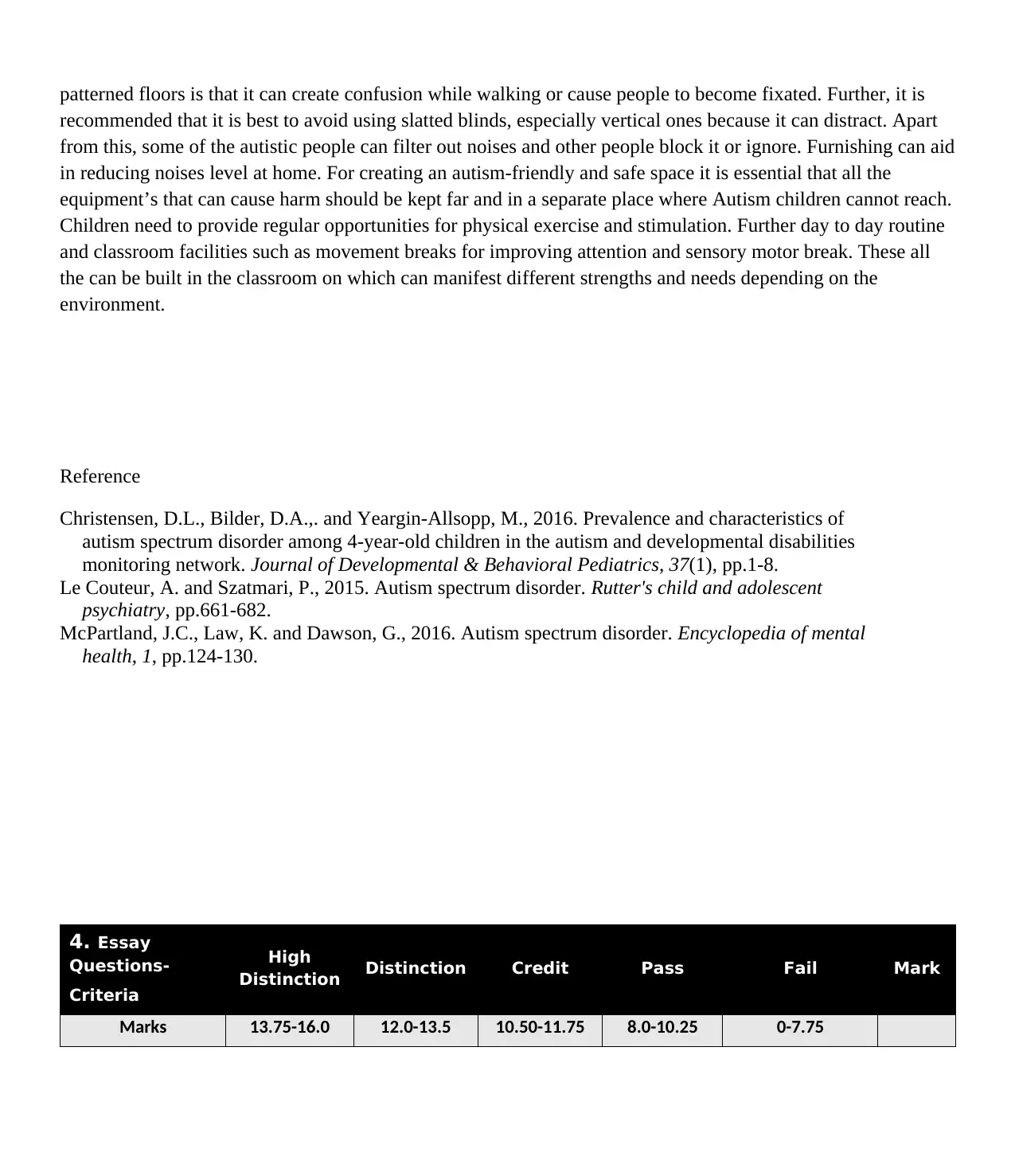
patterned floors is that it can create confusion while walking or cause people to become fixated. Further, it is
recommended that it is best to avoid using slatted blinds, especially vertical ones because it can distract. Apart
from this, some of the autistic people can filter out noises and other people block it or ignore. Furnishing can aid
in reducing noises level at home. For creating an autism-friendly and safe space it is essential that all the
equipment’s that can cause harm should be kept far and in a separate place where Autism children cannot reach.
Children need to provide regular opportunities for physical exercise and stimulation. Further day to day routine
and classroom facilities such as movement breaks for improving attention and sensory motor break. These all
the can be built in the classroom on which can manifest different strengths and needs depending on the
environment.
Reference
Christensen, D.L., Bilder, D.A.,. and Yeargin-Allsopp, M., 2016. Prevalence and characteristics of
autism spectrum disorder among 4-year-old children in the autism and developmental disabilities
monitoring network. Journal of Developmental & Behavioral Pediatrics, 37(1), pp.1-8.
Le Couteur, A. and Szatmari, P., 2015. Autism spectrum disorder. Rutter's child and adolescent
psychiatry, pp.661-682.
McPartland, J.C., Law, K. and Dawson, G., 2016. Autism spectrum disorder. Encyclopedia of mental
health, 1, pp.124-130.
4. Essay
Questions-
Criteria
High
Distinction Distinction Credit Pass Fail Mark
Marks 13.75-16.0 12.0-13.5 10.50-11.75 8.0-10.25 0-7.75
recommended that it is best to avoid using slatted blinds, especially vertical ones because it can distract. Apart
from this, some of the autistic people can filter out noises and other people block it or ignore. Furnishing can aid
in reducing noises level at home. For creating an autism-friendly and safe space it is essential that all the
equipment’s that can cause harm should be kept far and in a separate place where Autism children cannot reach.
Children need to provide regular opportunities for physical exercise and stimulation. Further day to day routine
and classroom facilities such as movement breaks for improving attention and sensory motor break. These all
the can be built in the classroom on which can manifest different strengths and needs depending on the
environment.
Reference
Christensen, D.L., Bilder, D.A.,. and Yeargin-Allsopp, M., 2016. Prevalence and characteristics of
autism spectrum disorder among 4-year-old children in the autism and developmental disabilities
monitoring network. Journal of Developmental & Behavioral Pediatrics, 37(1), pp.1-8.
Le Couteur, A. and Szatmari, P., 2015. Autism spectrum disorder. Rutter's child and adolescent
psychiatry, pp.661-682.
McPartland, J.C., Law, K. and Dawson, G., 2016. Autism spectrum disorder. Encyclopedia of mental
health, 1, pp.124-130.
4. Essay
Questions-
Criteria
High
Distinction Distinction Credit Pass Fail Mark
Marks 13.75-16.0 12.0-13.5 10.50-11.75 8.0-10.25 0-7.75
⊘ This is a preview!⊘
Do you want full access?
Subscribe today to unlock all pages.

Trusted by 1+ million students worldwide
1 out of 12
Your All-in-One AI-Powered Toolkit for Academic Success.
+13062052269
info@desklib.com
Available 24*7 on WhatsApp / Email
![[object Object]](/_next/static/media/star-bottom.7253800d.svg)
Unlock your academic potential
Copyright © 2020–2025 A2Z Services. All Rights Reserved. Developed and managed by ZUCOL.